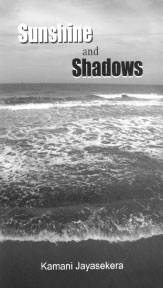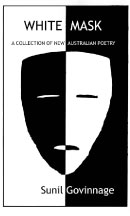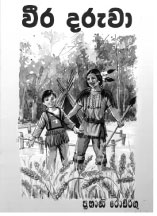|

Poetry and the theme of loss
Reviewed by Prof. Wimal Dissanayake
Where else am I walking even now Looking
for me - W.S.Merwin
‘Sunshine and Shadows’ is Kamani Jayasekera’s second collection of
poetry in English, the first being ‘Petals in the Wind.’. This new
volume of poems, consisting of over fifty poems, represents an advance
over her work in terms of content, language and representational
strategies. Her poems deal with largely personal experiences,
observations, reflections, at times interwoven with social observations.
These poems, which are pages from her lived world, also contain a spine
of social commentary, that serve to underline the dangers of spiritual
stasis and moral entropy. Many of her poems the traverse the distance
between desire and despair, possibility and fulfilment, individual
yearnings and social imperatives, sound of tradition and call of
modernity. The complex negotiations involved in this commute only serves
to draw attention to the dramatic divergences between these polarities.
 The theme of loss is central to Kamani Jayasekera’s poetry - loss of
desire, loss of trust, loss of faith, loss of conviction and the loss of
language. This theme of loss emerges as a connective thread running
through the poems and investing them with a recognizable unity. It can
be described as the activating and organizing topos in her poetry. It is
not always easy to explore the theme of loss without falling into
sentimentality, self-pity, bathos, and even morbidity, - failings that
have disfigured the writings of some of the greatest poets. It is to
Kamani’s credit that she has, for the most part, succeeded in avoiding
these tempting pitfalls. The theme of loss is central to Kamani Jayasekera’s poetry - loss of
desire, loss of trust, loss of faith, loss of conviction and the loss of
language. This theme of loss emerges as a connective thread running
through the poems and investing them with a recognizable unity. It can
be described as the activating and organizing topos in her poetry. It is
not always easy to explore the theme of loss without falling into
sentimentality, self-pity, bathos, and even morbidity, - failings that
have disfigured the writings of some of the greatest poets. It is to
Kamani’s credit that she has, for the most part, succeeded in avoiding
these tempting pitfalls.
Many of the poems deal with the poet’s relation to objects, places,
people, and landscapes, and in poems of this nature, the centre of
gravity almost always shifts to the subject . However, Kamani has sought
to maintain a nice balance between the poetic subject and poetic object
thereby foregrounding the attachments, affiliations, and interaction.
These attachments, affiliations and interactions themselves, very often,
end with the anxieties and raptures of newer realizations and
unanticipated recognitions. It is through this means that Kamani seeks
to attain the wisdom that the eminent American poet, Robert Frost,
thought was the destination of poetry.
As I stated earlier, Kamani’s poems, by and large, are personal,
gentle, compassionate; they almost carry the gentleness of their
conviction. However, within their autobiographical trajectories, are
embedded engagements, never in a high-handed way, with social, moral,
ethical issues. This move has the effect of investing her poems with
another layer of significance. The impulse for this engagement grows of
her visible desire to braid private necessity with public conviction. At
times, this tends to generate, to my mind, a wholly understandable
tensions growing out of alienations and dislocations in new emotional
and cognitive spaces.
Kamani Jayasekera’s intention has been to map diverse emotional
terrains with precision, wit and discernment. Her preferred mode of
approach has been to aim for compactness and compression – to strip
language to its bare essentials. Her style is unmannered and
unembellished and often colloquial. This makes her language simple, but,
in many instances, there is richness to that simplicity. Her poems, with
their interplay of certainties and uncertainties of meaning, gesture
towards a pregnant silence that inhabits a space beyond language. Her
desire to venture into linguistic and cultural silences marks her best
poems. She is keen to tap into a layer below words in order to reach a
space beyond words. And her compositions are not unduly weighed down by
rhetoric, a fact that lends greater force to this desire.
Let me illustrate my conviction with a few examples. The poem
'Parents' consists of four lines
When living, I had little time
To spend with you.
In death you live
Eternally by my side.
Here, a whole world of deeply felt emotion is compressed into four
lines, and the matter-of-factness of the statement adds to the poignancy
of the situation. The poem titled the 'Ruins', Kamani captures a tragic
scene with the above stated cultural silence surrounding the poem,
despite the unevenness of statement.
Wounded by missiles
Dried up by the beating sun
Washed over in rainy seasons
An empty shell of a temple remains
In no mans land in solitude
Where have the gods gone?
Where have they fled to?
Destroyed by both enemy and friend
Caught between cross fire
Ruined by the same people no doubt
Who fall at their feet
Seeking favours
At a better time in a better place
Many of Kamani Jayasekera’s poems are short; however, they could be
shorter. I was reminded of a comment made by a critic on the poetry of
the distinguished American poet, Robert Creeley. ‘There are two things
to be said about Creeley’s poems: they are short; they are not short
enough.’
Kamani Jayasekera’s poems display the activating power of a
triangular relationship – the local experiences and concomitant modes of
sensibility, the English language and the intertextualities provided by
classical Greek and Roman cultures. This triangular intersection gives
some of the poems a reverberative power. The idea that life is in
incessant flux, that one does not step into the same river twice, is
central to the thought of Heraclitus as indeed it is for Buddhist
thinking. What is interesting about KamaniJayasekera’s poems is that she
is seeking in this Heraclitian flux a point of stable order, a graspable
pattern; at a deeper level of imaginative apprehension, this is indeed a
desideratum that Heraclitus had in mind too. That human beings are
perceived to be in a permanent state of exile makes this ambition all
the more compelling.
As I suggested earlier, Kamani abhors excess, ornamentation,
heightened self-display preferring a mode of measured statement driven
by restraint. Her bent is in the direction of understatement. There is
no attempt at overt moralizing or loading the dice. She also avoids
excessive focus on aesthetics as that can easily lead to a malady of
imagination. Her poems are sustained by a conviction that exuberance of
enactment often undercuts the essence of that very effort. She shows
little interest in reaching out to spaces that lie beyond one’s grasp,
recognizing full well the fact that the spaces within once grasp are
complex and many-sided enough. She hums around the edges of
autobiography without making an orgy of self-exhibitionism. Her thematic
interests and stylists propensities are united in her privileging of
understatement; she realizes that sometimes less can be more.
As with all collections of poetry, including those of the finest, not
all poems gathered in this volume are equally strong. Some appear to be
sketches that could attain their full height in later incarnations; some
invite metaphorical intervention to relieve them of their prosiness,
while others seek architectonic refurbishing. Rhythmically speaking,
some could gain by a more vigorous athleticism. A close friend of mine,
the eminent American poet Reuel Denney, in a conversation that took
place many years ago, told me that fancy footwork in poetry should not
be abandonment, but rather an enlargement, of the virtues of prose. I
still think it is a useful piece of advice. Gertrude Stein once
proclaimed, ‘Remarks are not literature.’ This is again an admonition
well worth adhering to. We as writers often fall short of the mark we
set for ourselves; how we long to chisel that perfect poem! How we seek
to promote the ideal union between language and emotion! I recommend
Kamani Jayasekera’s new collection of poems, interesting as it is, not
so much for its achieved art as for its promise, its display of
possibilities for future growth.
Avarjana:
Voyage into the turbulent life
Reviewed by Ranga Chandrarathne
Avarjana, a novel by Srimathi R. Weerasuriya portrays life and times
of an era through personal memoirs of Sitara, a pivotal character and
the narrator of the novel. The story is linked with the fate of Sitara
who has to live with a rich aristocratic family foregoing many
opportunities in life and keeping some family secrets of Ravinatha’s
family.
The story of the novel revolves around the life of Sitara who lost
her parents and has to live with her paternal uncle until he died in a
vehicular accident. Sitara’s kind uncle and aunt have to take into
custody Chamara, a child born out of wedlock while Chamara’s young
mother leaves back for Middle east for employment. The narration moves
on as Chamara is adopted by rich aristocratic couple, Ravinatha and
Uthpala who have no children.
 The large part of the novel is in the form of Sitara’s reminiscences.
She narrates how she has to spend the life with Ravinatha family because
of Chamara. The large part of the novel is in the form of Sitara’s reminiscences.
She narrates how she has to spend the life with Ravinatha family because
of Chamara.
“As the darkness gathers, the electric lights of the fleet of
vehicles, plying along the distant road fall on men and women walking on
the road making their silhouettes clearer. For a moment, night would
arrive and then a day would dawn and another evening would pass by in
the same manner. I am reaching seventeen and how many such evenings
could I experience? A breeze brings about a chill to the body. I stepped
back into the house. At the far end of the garden, the graves of
Ravinatha as well as his family members were seen through the darkness.
They shone white as light from a lamp post cast on them. Chamara takes
the trouble to keep graves clean. What does he know of his ancestry?
Isn’t what he knows an illusion? He is an outsider to the family. He
believes that it is his duty to preserve the traditions that were handed
down from generation to generation. He respects convention. I could see
Keerthi Hamu engaged in a task under the cluster lamp in the living
room. I could recall how Chamara came home on his mother’s hands as a
lovely baby and uncle Nimal, aunty Kumari, Nilu and I looked at him with
love. What I know of him would die with me. He would leave this earth
with things he did not know….”
With the above moving passage, the author concludes the novel which
at a superficial level is a family saga. However, the author touches on
many themes while utilising nostalgia as a mode of narration. Poverty is
one of the themes that the author tries to develop through the
narration.
The major incidents in the novel such as the principal character of
the novel Sitara has to live with her paternal uncle and aunty,
Chamara’s biological mother has to leave him in the custody of Sitara’s
adopted family, adoption of Chamara by Ravinatha and Uthpala and Nilu’s
early marriage and leaving the country are more or less linked with
poverty. Through the lengthy descriptions of the aristocratic family of
Ravinatha and poverty- stricken Sitara’s family, the author has
attempted to portray diverse social strata in contemporary Sri Lankan
society. Though briefly described, Charmara’s mother represents Sri
Lankan migrant workers and the socio-cultural issues they face at places
of work in the Middle East.
Although the author has used colloquial Sinhalese idiom for the
narration, it has been used in such a manner grabbing the reader's’
attention throughout the novel. The author has used simple diction which
is appropriate for the narration. Dialogues have been used sparingly.
Except for the rapid sequence of tragic incidents which are at times
incredible, the author has developed the plot convincingly. Characters
have also been evolved in a logical manner in general and Sitara’s
character in particular.
The author has used Ravinatha’s diary entries to highlight the tragic
part of his life after the death of Uthpala due to cancer. Ravinatha led
a lonely life. The author vividly captures the personal tragedy that
befell Ravinatha through his diary entries as they were read by Sitara.
“…After Uthpala left me I had not thought of another woman. I
declined the marriage proposals made by my friends as I was quite unable
even to think of a marriage. My world was Chamara who Uthpala and I
adopted. The girl who was to bring him up became extremely helpful to
me. How nice if that girl be intimate with me? It would also be
beneficial for the child. I saw her at her home as a young girl. Have I
thought that she would ever be my wife? Some happenings in life are
astonishing. As Victor told me she has no reason to oppose this
proposal. I should explain her that the age gap would not be an issue. “
The central theme of the novel is nostalgia. The author has exploited
the theme at different levels. At one level, she has used nostalgia as a
mode of narration. The plot unfolds from the perspective of the
principal character Sitara, her early life and evolution of her into a
spinster and her recollections of the past and future. At the end Sitara
reconciles with her plight in retrospect of the life she could have
spent if she did not make sacrifices for the sake of the child, Chamara.
“None of my relations involved in these episodes is no more. Those
who surround me today are not my blood relations. They are all
strangers. But they all love me a lot. …my teacher parents with a
considerable fortune had not dreamt that their only daughter would live
among strangers. But I lead a contended life.
I have no repentance. From my friends as well as from Nilumi’s point
of view, I am leading a failed life. Nilumi is a grandma surrounded by
grandchildren. My longstanding friend Pujani, who has been keeping in
touch with me for a long time, now lives with her husband and children
in London….”
In the evening of her life, Sitara looks back on her childhood and
youth. Through the character of Sitara, the author offers a philosophy
of life which is different from the aspirations of an ordinary woman. 'Avarjana'
would be a novel experience for Sinhalese readership.
A fresh approach to portray Australian migrants and Aborigines
Reviewed by Prof. Santosh Sareen
Sunil Govinnage’s poetry explores the relationships between place and
identity, memory and desire. As a mature poet and an immigrant to
Australia, he is capable of seeing things which are not usually captured
by Australian poets who grew up in the former convict colony.
White Mask is Govinnage’s first collection of poetry. He selects a
wide variety of themes such as place, identity, love and despair as his
subject matter. He also writes about natural justice, human values, and
environment. Readers will find new imagery and fresh approaches,
particularly in the way Govinnage has portrayed Australian migrants and
Aborigines in his poetry.
 One of the most remarkable features of Sunil Govinnage’s poetry is
his strong desire to discover new values and explore other
interpretations of the Australian continent, its First Nation —
Aborigines —and the new settlers: migrants, both black and white, who
have arrived in the country since white colonisation. One of the most remarkable features of Sunil Govinnage’s poetry is
his strong desire to discover new values and explore other
interpretations of the Australian continent, its First Nation —
Aborigines —and the new settlers: migrants, both black and white, who
have arrived in the country since white colonisation.
Separation, in one form or another, is the conceptual builder of the
poems in this anthology. The poem entitled ‘A White Memory’, for
instance, carries a note of nostalgia for what was or has been. The
dominant case, the k?raka, of this poem is the ablative case, the
ap?d?na representing the case of separation and sorrow. The foreground
images are the memories of a lost land, a lost happiness, and a never
forgotten memory. In White Mask the poet is nostalgic for the rich
culture he has left behind in his country of birth, Sri Lanka.
‘I Don’t Write Poems in Sinhala Any More’ is another pivotal poem in
this collection. Notwithstanding the poem’s title, there is a note of
hope in this poem. In the poetry of the region, and very much so in
Govinnage’s poetry, there is an undercurrent of transcendental
resolution, renewal, a hope of meeting the past, a rebirth or a
perpetual unity that is not shattered by temporal facts of birth and
death.
There is a complex structure of emotional and intellectual experience
in Govinnage’s poetry. He uses powerful images captured from nature, and
from human and other person-made objects.
These images, their meanings and sensibilities bear the imprint of
the tropics; the images correspond to nature and to the traditions and
the values of the people.
In Govinnage’s poetry, we find not only a nostalgic presence of a
rich culture but the ability to recollect and narrate an interesting
interplay between home and exile. Govinnage has great mastery over the
English language and deftly handles images and other poetic devices.
In summation, the strength of Govinnage’s poetry lies in his ability
to investigate and provide new insights into matters that others take
for granted. He is also gifted in his native tongue — Sinhala — which
has a literary history of over 2,500 years. Therefore, he can easily
draw from a rich culture and the language in which he first wrote
poetry.
Nariyata Padamak

Ruwan Tharaswin’s latest book Nariyata Padamak carries a popular folk
tale of Sri Lanka in all three languages.
The story and the illustrations are by Ruwan Tharaswin. The English
translation is by Malini Govinnage. The story has been translated into
Tamil by Arul Sathyanathan. The book is printed by ANCL Commercial
Printing Department. It is an author publication available at leading
bookshops.
New arrivals
Veera Daruva

Prabhani Rodrigo’s Veera Daruva is a children’s story book based on a
North American folk tale. The book is illustrated with colour sketches
drawn by Gamini Abeykoon.
Veera Daruva is an Asiri publication.
Lakdiva Buddha Prathimava

Malinga Amarasinghe’s “Lakdiva Buddha Prathimava” will be launched at
Dayawansa Jayakody Bookshop, Ven. S. Mahinda Mawatha, Colombo 10 on
October 19 at 10 a.m.
The author is a senior lecturer in Archaeology at the university of
Kelaniya.
This is a Dayawansa Jayakody publication. |

